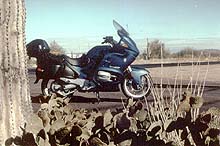And The Weather Gods Smiled - Motorcycle.com
January is not the month of choice to kick off a motorcycle test - at least not in Colorado. But when Motorcycle Online asked if I wanted to test ride BMW's R1100RT it looked like an opportunity not to be missed. Our weather had been fine over the holiday season, and bargain plane fares were in force. With a five-day forecast of good weather in hand, my passenger and I hopped a red-eye flight to Los Angeles for a wintertime two-up cross-country adventure.
We arrived at MO's secret headquarters by mid-morning, but had very little time for chit-chat. Threatening clouds loomed overhead, so we hurried through Editor Plummer's pre-flight briefing and prepared for our journey home. The R1100RT was beautifully finished in metallic blue, and made a fine first impression. Included with the bike was a BMW Kalahari riding suit with matching BMW-by-Widder electric vest. I replaced my traditional leather jacket and pants, sweater and snowmobile suit in favor of BMW's suit, although it was disconcerting to exchange gear that's known to do the job for untried equipment. In any case, I refused to give up my trusty DryRider rainsuit, in spite of the high-tech BMW suit's watertightness claims.
Learning to operate BMW's double-handle latch system on the R-style bags and top case took some time. Their operation is not obvious, but once learned it is positive, quick and convenient. Although the bags themselves are quite capacious, the top case has an odd interior shape and is best suited for small items that need to be within easy reach.
Our plan was to take Interstate 10 all the way to Phoenix, pick up US60 for some scenic two-lane riding to Socorro, New Mexico, then north on I-25 to Denver. This route avoids high altitudes, although it can occasionally be quite troublesome across the high eastern plains of Arizona. There are only two real trouble spots; Glorietta Pass between Santa Fe and Las Vegas, New Mexico (site of an obscure Civil War battle in which the Colorado Militia soundly thrashed a unit of Confederate Regulars from Texas), and Raton Pass on the Colorado-New Mexico border.
It took no more than a hundred miles to understand why Corbin does a land-office business in replacement BMW seats. There must be some fundament(al) difference between German and American posteriors. Frequent stops for passenger butt rest were necessary throughout the trip, and eventually she was forced to improvise a seating arrangement out of a piece of foam rubber and a pair of shower sandals that seemed to help.
A stop for burgers at a lonely exit between Indio and Blythe brought about attempted conversation with some biker types around the picnic tables. They were headed in the opposite direction by automobile, and were dumbfounded by our presence, our motorcycle and our intended ride to Colorado. They took a close look at the big RT, especially at the Paralever swingarm ("What holds the wheel on?"), but attempts to point out and explain the features failed completely. It's difficult to complain about the Beemer's seats to a Harley hardtail rider.
We got an excellent early start on the 140 mile hop to Phoenix, Arizona the next morning. With bright, sunny weather there was little to do on the interstate but ride and watch the saguaro cacti go by. It provided an opportunity for a fuel mileage test however, so we kept the big speedometer on a steady 85 nearly all the way. The US60 exit on the east side of Phoenix brought us to Apache Junction, a city composed entirely of the motorhomes and RV trailers of "snowbirds," retirees who go south for the winter. We stopped for a fill-up, and calculated the mileage over a sandwich. The R1100RT returned an outstanding 38.1 mpg, fully loaded and two-up while cruising mostly at 85 mph.
By the time that we arrived at Show Low a grand Arizona sunset was in full color, but we decided to stretch our day another 40 miles to Springerville. This is a high plateau region and it got cold in a hurry after dark, so our first test of the R1100's electrically heated handgrips was in order. I had never tried heated grips before, and was surprised at their effectiveness. At first glance, such gadgets seem like so much frippery, but these are a practical addition to a tourer of the RT's class. Still, a warm room and a hot meal at Springerville was welcome after the cold ride.
This area is also home of the National Radio Astronomy Observatory's VLA (Very Large Array) radiotelescope, consisting of 27 giant dish antennas on nine miles of railroad tracks in a valley west of Magdalena, New Mexico. They have a visitor's center and tours, and I'm certain they'd be happy to see just about anybody, as it's a lonely-looking place.
After a quick stop for a leg stretch at Socorro, we rejoined the Interstate Highway System, and threw the helm over for the northerly run up I-25. As the cloud cover steadily increased, we beat our way to windward (the crosswind was getting up to about 40 miles per hour) another 75 miles to Albuquerque. By now it was obvious that the weather was going downhill and we should get as far as we could before the storm started, then find a spot to wait it out. With mountain passes looming, we needed to get a bit farther north so we'd be within range of Denver the next day.
BMW's Kalahari riding suit was absolutely saturated with water, but the GoreTex inner liner had completely stopped it, leaving this rider cold, but bone-dry. It's an odd system, but it appears to work. We've always thought the waterproof part ought to be on the outside.
We rigged a clothesline next to the motel room's old-time wall heater and hung everything up to dry before retiring to the thrum of rain on the roof. It was anybody's guess what the riding conditions might be like in the morning.
They weren't all that bad, as it turned out. Puddles in the parking lot were iced-over, but the sun was out and things looked to be clearing up. We snapped the luggage on, and commenced to ride.
The 60 mile stretch between Santa Fe and Las Vegas, New Mexico is a very nice alpine ride, even on the interstate. It had been cold and wet up there, but by staying in the dry parts of the lane and avoiding shady spots where ice was likely, we had no trouble. As the sun rose higher, the road completely dried out, and the 130 miles to Raton across the flats went fairly quickly. Our Beemer's low-fuel light came on just as we pulled into Raton, allowing us to get an accurate reading of the range-to-reserve, some 230 miles since filling up in Albuquerque. The RT has long legs indeed.
On our home turf again, the remaining 225 miles of Interstate to Denver was covered without incident, and included a little stop for hellos at a friend's house in Colorado Springs. The temperature dropped drastically during our last few hours though, so the electric vest was plugged in and turned on. Although the vest was nice and feels like there's sunshine on your back, it does nothing for your arms. Next time, bring a sweater.
It was just below freezing as we rumbled into Denver shortly after sunset. Our trip totaled 1375 miles, and we covered it in three-and-a-half winter-shortened days. Our BMW R1100RT performed faultlessly and proved itself a very capable long-distance tourer, with plenty of extra oomph for two-up full-load high-speed running, and good enough handling to be entertaining in the twisty parts. It's a much more versatile machine than those in the super-dreadnought Gold Wing class, and though expensive, it's a quality piece. Now if they could just do something about those seats!
More by David Tharp

































Comments
Join the conversation